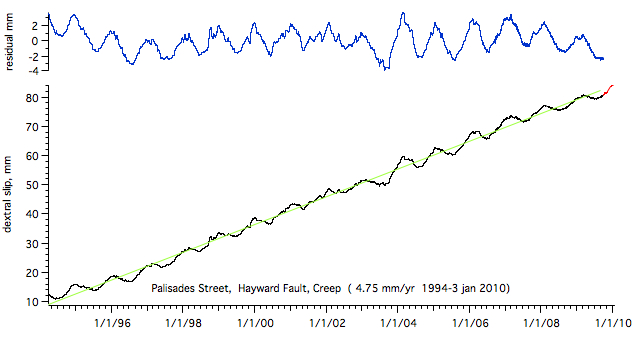
Palisades Street, Hayward, Creep 1994-2010 Site map and cross-section For real time data click here user=geo, password=hobo
The mean creep rate 2 April 1994-1 Oct 2009 has been 4.75 mm/yr (see image below). Seasonal thermoelastic signals at this site are large (±2.5 mm) since the instrument is buried beneath a blacktop road surface. No apparent changes in rate are evident with the excepion of the first two years which may be settlement following installation. Road traffice has no effect on the creep signal. A large steel utility pipe was buried beneath the western end of the creep meter length-standard in September 2006 requiring the removal of a mechanical offset of ≈3mm. The loss of datum is less than 0.3 mm.
1. All data 1994-2009 . Time tagged variable spaced data. A .csv zipped file. The data are listed with time tags that vary in time interval from 10 minutes to 1 hour.
2. All data - Hourly data (Equally spaced data at hourly intervals - a comma-separated zipped file).
3. All data - Ten-minute samples interpolated from raw 15 minute, 10 minute and 5 minute samples -- a comma-separated zipped file.

The 1994/09 calibrated data interpolated to hourly values may be downloaded here . [2 April 1994 to 1 October 2009. FORMAT. The data are in two columns with a one line header labelled coHP_date [date in excel format (MM/DD/YY hh:mm:ss)], amd coHPmm [dextral slip to four decimal places of which only two are significant]. The starting value is arbitrary. There are 815178 rows and two columns and the unpacked .csv file is 20 Mb. The zip file of variable spaced data is 3 MbThermoelastic effects have not been suppressed from these data. The two columns are space delimited date&time (MM/DD/YY HH:MM:SS) , and calibrated dextral slip in mm. Only two significant places of decimals are meaningful. The detrended data show an approximate sinusoidal ±2.5 thermoelastic signal, which after the removal of an annual sine-wave term reduces to a ±1.5 mm residual.
The cell transmitter flooded in November 2009 and was replaced 16 Dec 2009. The data are sampled at 15 minute intervals thereafter.